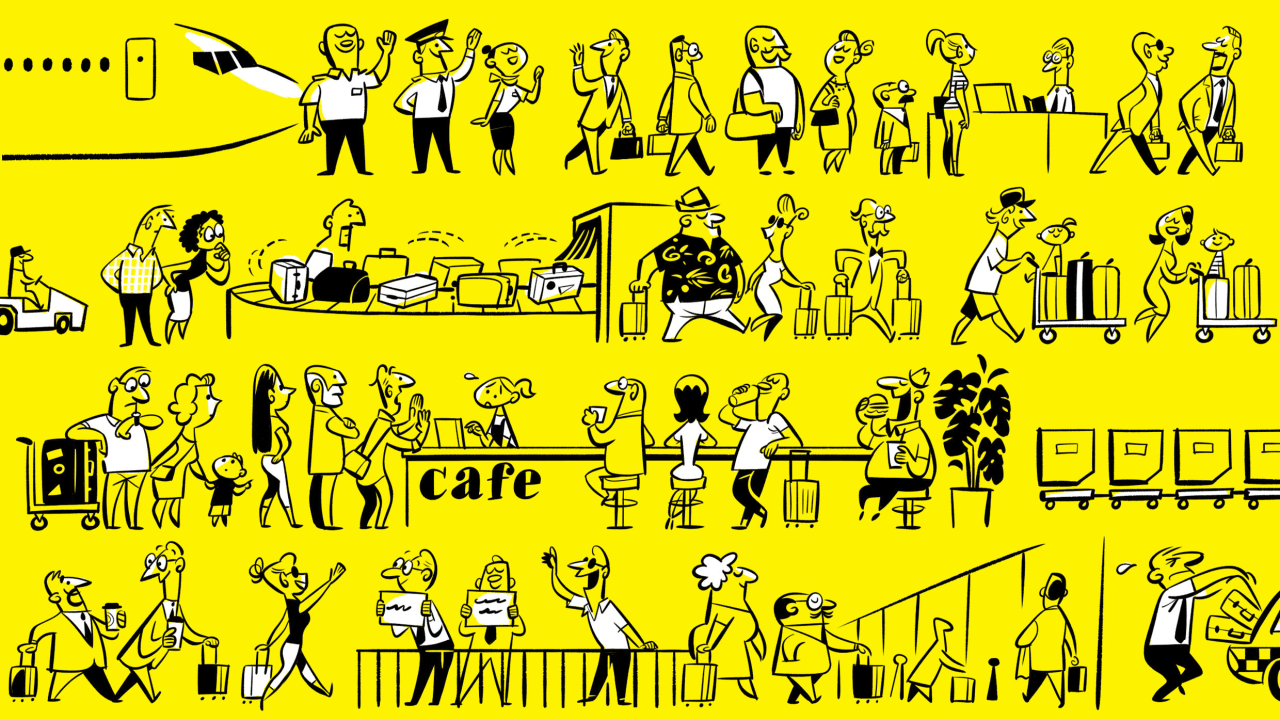Business travel is back—and getting better. Here’s how to make your next work trip feel like leisure
In the era of hybrid teams, everyone is a road warrior—not just sales teams and C-suite execs. It’s part of why business travel spending is expected to finally reach, and perhaps surpass, pre-pandemic levels by the end of the year, according to Deloitte. But, as with everything, work trips are not what they were in 2019. From airlines to banks, companies are finding new ways to make business travel easier—and even a little fun. 1. Grab a premium seat—there are more of them. Business fliers whose spending limits allow for upgrades have a growing number of opportunities to escape economy class. That’s because carriers—which know deep-pocketed corporate passengers boost margins—have been increasing their business and premium economy seat counts, especially on trans- and intercontinental routes. American Airlines, in particular, has been investing in upscale offerings that CEO Robert Isom calls “one of the bright spots” of the business. Key to that investment are its forthcoming Flagship Suites, which will feature sliding doors for maximum privacy along with lie-flat seats and exclusive amenity kits. These suites will debut on new long-haul, mostly international aircraft, and will replace America’s Flagship First seats on older planes. The suites will be joined by new luxe, recliner-style premium economy seats with wireless charging. The airline expects to debut both the suites and the premium economy seats later this year. —David Salazar 2. Airline lounges are great. Credit card lounges are next level. As American Express, Chase, and Capital One battle to capture high-spending cardholders by piling on travel perks, their airport lounges—with worker-friendly essentials and high-end amenities—are becoming destinations unto themselves. AmEx leads the pack with its 29 Centurion Lounges globally (and access to another 1,400-plus others) that are open to Platinum Card (annual fee $695) holders. Its latest opened at Reagan National Airport (DCA) in July and includes a cocktail bar, workstations, and shower suite, along with original art from D.C.-based artists. Chase’s Sapphire Reserve Card (annual fee $550) offers access to Priority Pass’s 1,500 lounges, plus four signature Chase Sapphire Lounges. The newest, in New York’s LaGuardia, even offers three luxe Reserve Suites (from $2,200 for three hours) with curated menus and private bathrooms and showers. It’s all part of an effort to “fully re-envision” the airport experience, says Chase’s Dana Pouwels, who leads the bank’s airport lounge benefits. Capital One operates three lounges for Venture X cardholders (annual fee $395) and forthcoming, food-focused “landings” at DCA and LGA with menus created alongside José Andrés Group. To combat crowds, the Capital One mobile app has a digital waitlist and real-time capacity info. —Stirling Kelso [carousel_block id=”carousel-1725371284363″] 3. Book a club room for maximum productivity—and luxury. In 2023, two-thirds of corporate travelers extended a business trip into a vacation, according to Deloitte, which means hotel chains with amenities bridging work and leisure can boost occupancy. To do that, new locations from hotel chains are reviving the “club floor” concept, giving guests in certain rooms access to exclusive spaces for both business and relaxation. The Ritz-Carlton New York, NoMad, opened in 2022, features a 36th-floor club lounge with workspace and five daily “culinary presentations.” Clubs also feature at Hilton’s growing Signia brand, which opened its flagship hotel adjacent to Atlanta’s Georgia World Congress Center this year. Brand leader Teddy Berlin says Club Signia’s “experiential moments” target productivity and play—from a private meeting room to a cocktail bar. —Madeline Nguyen 4. Go beyond TSA PreCheck and Global Entry with your own private terminal. The TSA line is no longer a great equalizer. High-profile fliers seeking an exclusive airport experience helped spur Amina Belouizdad Porter to launch her private-terminal company, PS, in 2017 at Los Angeles International Airport. Now, with a new, 8,575-square-foot location at Atlanta’s Hartsfield-Jackson International Airport and a crop of post-pandemic travelers who want luxury even when flying commercial, PS is no longer just for celebs. Outbound PS travelers are escorted to the company’s terminals, where they are plied with food, drink, and add-on services like massages and manicures. Before being driven across the tarmac to their plane, they go through a private TSA screening. On arrival at LAX, domestic fliers and their bags can be taken home directly from the plane; international fliers get a dedicated customs agent. “For business travelers, PS eliminates friction,” Porter says. PS costs $4,850 for a group of four in a suite, or $1,095 per person in the shared salon; annual memberships (from $1,250) bring those costs down. —Heidi Mitchell 5. Don’t assume you’ll be flying. As Europe a

In the era of hybrid teams, everyone is a road warrior—not just sales teams and C-suite execs. It’s part of why business travel spending is expected to finally reach, and perhaps surpass, pre-pandemic levels by the end of the year, according to Deloitte.
But, as with everything, work trips are not what they were in 2019. From airlines to banks, companies are finding new ways to make business travel easier—and even a little fun.
1. Grab a premium seat—there are more of them.

Business fliers whose spending limits allow for upgrades have a growing number of opportunities to escape economy class. That’s because carriers—which know deep-pocketed corporate passengers boost margins—have been increasing their business and premium economy seat counts, especially on trans- and intercontinental routes. American Airlines, in particular, has been investing in upscale offerings that CEO Robert Isom calls “one of the bright spots” of the business. Key to that investment are its forthcoming Flagship Suites, which will feature sliding doors for maximum privacy along with lie-flat seats and exclusive amenity kits. These suites will debut on new long-haul, mostly international aircraft, and will replace America’s Flagship First seats on older planes. The suites will be joined by new luxe, recliner-style premium economy seats with wireless charging. The airline expects to debut both the suites and the premium economy seats later this year. —David Salazar
2. Airline lounges are great. Credit card lounges are next level.
As American Express, Chase, and Capital One battle to capture high-spending cardholders by piling on travel perks, their airport lounges—with worker-friendly essentials and high-end amenities—are becoming destinations unto themselves. AmEx leads the pack with its 29 Centurion Lounges globally (and access to another 1,400-plus others) that are open to Platinum Card (annual fee $695) holders. Its latest opened at Reagan National Airport (DCA) in July and includes a cocktail bar, workstations, and shower suite, along with original art from D.C.-based artists. Chase’s Sapphire Reserve Card (annual fee $550) offers access to Priority Pass’s 1,500 lounges, plus four signature Chase Sapphire Lounges. The newest, in New York’s LaGuardia, even offers three luxe Reserve Suites (from $2,200 for three hours) with curated menus and private bathrooms and showers. It’s all part of an effort to “fully re-envision” the airport experience, says Chase’s Dana Pouwels, who leads the bank’s airport lounge benefits. Capital One operates three lounges for Venture X cardholders (annual fee $395) and forthcoming, food-focused “landings” at DCA and LGA with menus created alongside José Andrés Group. To combat crowds, the Capital One mobile app has a digital waitlist and real-time capacity info. —Stirling Kelso
[carousel_block id=”carousel-1725371284363″]3. Book a club room for maximum productivity—and luxury.

In 2023, two-thirds of corporate travelers extended a business trip into a vacation, according to Deloitte, which means hotel chains with amenities bridging work and leisure can boost occupancy. To do that, new locations from hotel chains are reviving the “club floor” concept, giving guests in certain rooms access to exclusive spaces for both business and relaxation. The Ritz-Carlton New York, NoMad, opened in 2022, features a 36th-floor club lounge with workspace and five daily “culinary presentations.” Clubs also feature at Hilton’s growing Signia brand, which opened its flagship hotel adjacent to Atlanta’s Georgia World Congress Center this year. Brand leader Teddy Berlin says Club Signia’s “experiential moments” target productivity and play—from a private meeting room to a cocktail bar. —Madeline Nguyen
4. Go beyond TSA PreCheck and Global Entry with your own private terminal.

The TSA line is no longer a great equalizer. High-profile fliers seeking an exclusive airport experience helped spur Amina Belouizdad Porter to launch her private-terminal company, PS, in 2017 at Los Angeles International Airport. Now, with a new, 8,575-square-foot location at Atlanta’s Hartsfield-Jackson International Airport and a crop of post-pandemic travelers who want luxury even when flying commercial, PS is no longer just for celebs. Outbound PS travelers are escorted to the company’s terminals, where they are plied with food, drink, and add-on services like massages and manicures. Before being driven across the tarmac to their plane, they go through a private TSA screening. On arrival at LAX, domestic fliers and their bags can be taken home directly from the plane; international fliers get a dedicated customs agent. “For business travelers, PS eliminates friction,” Porter says. PS costs $4,850 for a group of four in a suite, or $1,095 per person in the shared salon; annual memberships (from $1,250) bring those costs down. —Heidi Mitchell
5. Don’t assume you’ll be flying.

As Europe adopts regulations encouraging train travel over flights, companies with international footprints, like EY, are handing down company-wide carbon budgets, tasking employees with choosing lower-emission modes of business travel. Even in the U. S., where passenger travel is just a fraction of overall train traffic, the White House has asked federal employees to travel by train or electric vehicle whenever possible. No stranger to Beltway commuters, Amtrak is rolling out a new fleet of Acela trains this year. Initially slated for 2021, the Acela revamp coincides with growing demand along the Boston to D.C. Northeast Corridor, which added some two million riders in 2023. At the same time, private rail operator Brightline is courting business travelers to its route from Orlando to Miami, with half of its 232,000 riders in May taking work trips. As Brightline builds a route from Las Vegas to California, SVP Ben Porritt says amenities such as Starlink Wi-Fi are designed to make the trains an “office on the go.” —Henry Chandonnet
6. Take your points and get yourself a travel deal.

“Using points strategically used to take serious games-manship,” says Adam
Morvitz, cofounder and CEO of Point.me, which helps travelers book flights by tapping into the estimated $30 billion reservoir of unused miles and points. Morvitz and his team of self-described “points nerds” turned the arcane process of using credit card and airline rewards to book travel—sometimes off-loaded to concierge services—into a self-service, subscription-based search engine. Access to Point.me’s booking tool starts at $129 a year and lets travelers find and compare awards flight options, with step-by-step booking instructions. Its $260-per-year premium tier includes a personalized points strategy consult and discounts on Point.me’s concierge booking service. Point.me is so easy to use that American Express is offering cardholders complimentary access to an AmEx-tailored version of the platform. Cardholders can book directly with AmEx Membership Rewards points or (if the airline itself offers a better deal) transfer those points to an airline loyalty program and book that way. Point.me also now works with corporate travel managers to book trips with company points, which Morvitz says can result in “flight upgrades and travel perks all year long.” Additionally, companies like McKinsey and Meta offer Point.me memberships to employees as a work benefit. —SK
7. Stop worrying about your travel expense report.

Managing the ballooning costs of increased business travel has become crucial for companies of all sizes. At financial automation platform Ramp, travel now accounts for 20% of its clients’ annual expenses (up from 10% in 2021). Ramp’s corporate cards—which are customized based on a company’s expense policy—and spend-management tools take pressure off travel managers and employees alike, eliminating the need for expense reports. Businesses can blanket approve or deny transactions from specific merchants, and Ramp can automatically pull receipts for approved expenses directly from email and apps like Lyft. This year, Ramp created a travel-booking portal with inventory powered by Priceline that’s meant to streamline booking and managing business trips. Once a trip is booked, Ramp knows to categorize any purchases during that time period as a travel-related expense. “Our main view,” says Ramp CEO and cofounder Eric Glyman, “is that your expense report should do itself.” —DS






















